SHEDDING LIGHT ON WARNER’S—AND THE STATE’S—RURAL AFRICAN-AMERICAN RESIDENTS
Across the story of America, the history of black people remains a darkened corner. We’ve failed other people—the Irish faced harsh discrimination, Native Americans are still routinely marginalized, and Japanese Americans serving in World War II saw their families interned—but the long, sorry tale of America’s sin against its black citizens is remarkable for both its length and its scope.
Equally as remarkable are the incredible dignity displayed and successes achieved by many slaves and their descendants.
New Englanders can rightly claim a significant role in ending the outright slavery of black people because the abolitionist movement flourished here. But it’s an imperfect history. For decades, most New Hampshire residents believed that there was no slavery here and that racism was never a problem simply because we lived in one of the whitest states in the country. That fallacy ended in the 1990s, when Seacoast residents uncovered the little-known history of black slaves and servants who worked in and around Portsmouth during the colonial era. Today, the Portsmouth Black Heritage Trail allows people to follow this rugged trek.
But JerriAnne Boggis, executive director of the nonprofit organization that created the Portsmouth trail, says there’s still more that needs to be told. She’s working with historians around the state to fill in the largely hidden history of black people who lived in rural New Hampshire towns during the early days of the nation—places like Andover, Hancock, Milford, and nearby Warner.
“Warner! Can you imagine?” JerriAnne asks rhetorically. “When you think of this out-of-the-way place! But there was a community of colored people there. And it was not just one family, they were integrated into the community. They were part of the town.”
“The fact is that there was a community from at least 1810,” confirms Rebecca Courser, executive director of the Warner Historical Society. “But it was not until 1850 that they were listed in the census.” Before that, individuals in white families were listed by age under the head of the household, but black families were simply numbered as freed colored persons, sometimes in the margins.
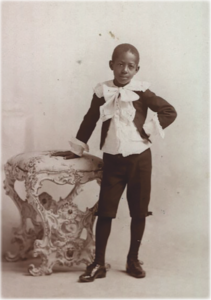
Tony Jones was chosen to be the page boy for the Simonds Free High School Class of 1896. His mother, a widower named Annie Jones, had moved her family north from South Carolina to work in the household of a white family, Henry and Sarah Davis of Warner. Marion Davis, the couple’s daughter, was a graduate of the high school, which was why Tony was chosen to participate in the graduation activities.
Rebecca is excited about the possibility of having spots in Warner eventually listed on the new Black Heritage Trail of New Hampshire. That project is currently being developed in conjunction with JerriAnne and the Portsmouth-based group.
“You can drive by the William Haskell House,” Rebecca says, referring to the former home of a black man renowned as a talented basket maker. “In Waterloo [another section of town], there’s the house where Clarence Steward lived, who was the [African-American] secretary for Nehemiah Ordway.” Ordway was a prominent politician who served as Sergeant of Arms at the U.S. House of Representatives and a governor of the Dakota Territories.
“Then there’s the Waterloo School House, the Roby School House, and the Village and Burnt Hill schools,” Rebecca continues, noting that black and white children were integrated in those institutions.
A Warner leg of the statewide trail could also commemorate the black community that lived on what’s now called Poverty Plain Road—but was once known by the racial slur N—r Plain. Or there could be a marker near the wetlands alongside old Prince Hastings’s home, nicknamed Chocolate Swamp.
Rebecca was serving as Warner’s assistant town clerk several years ago when she began seeing things in old town records that piqued her interest about former black residents. “I would run across this material—vital records and deeds, things like that—and I was curious,” she recalls. “Who were these people? What were their lives like?”
As others have found, resolving those questions is hard. Most black Americans had little or no education, so there are few personal journals or other papers that have been preserved. One significant exception is Our Nig: or, Sketches from the Life of a Free Black, which was published in 1859 (see sidebar).
In addition, what is available doesn’t provide a full picture of how most residents saw their black neighbors. “What did the silent majority of people in town think of them?” Rebecca asks. “We don’t hear about it. We don’t know.”
What exists is not heartening. In town histories written in the later 1800s, white residents frequently recalled their black neighbors as stereotypically simpleminded and naturally subservient. “The stories that we see written up are usually not flattering,” Rebecca says. “Many of them are derogatory. ‘They were stealing things,’ or ‘They’re alcoholic.’”
What Rebecca and other historians around the state are discovering is that most black residents were good, law-abiding citizens who paid their taxes and supported their communities. “There were at least some Afro-American men who, after the Revolutionary War, were amassing land here and there,” JerriAnne explains. “And they would donate land to the town for a school or for a library. . . . They were doing the same thing that we think of as something the founding white fathers were doing,” she says.
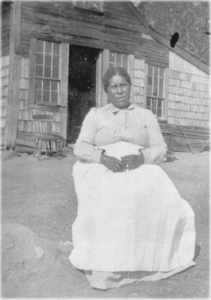
Mary Moody resided on the Plains Road in Warner and was head of a multigenera- tional household. This photograph was taken when Mary was in her mid-fifties in the 1890s. Mary was paid to nurse other residents in the area and often received monies from the town pauper fund for food and clothing for her grandchildren.
Anthony Clark was a multifaceted man who made a significant impact on his community. He came to town in the early 1800s and may have been among the black men awarded their freedom for fighting in the Revolutionary War. Anthony enlisted when he was 19 years old and is mentioned on official papers as being “on command at the lines,” i.e., engaged in active duty.
Anthony worked as a laborer in Warner, which was a common job for freed black men, but he was also an accomplished musician and craftsman. In 1804, Anthony married Lucinda “Lucy” Moor of Canterbury in a Warner church. Over the years, the couple raised 10 children, and for many years the family was prominent at social gatherings around the region.
According to one report, the Clarks typically started out by pitching a tent at outdoor events, like musters and town celebrations. Anthony would start playing his fiddle to draw a crowd and his daughters—Sual Hall and Lydia Clark—would dance a jig. Soon men of all ages would “pitch-a-penny” for the chance to dance with them. In between, the Clarks sold their homemade gingerbread.
A neighbor known as Prince Martin may have sometimes joined the music. “Another Negro, born in Africa, for many years lived in the Warner woods under the name of Prince Martin,” one white resident recalled in 1823. “He could sing many songs and play on the bones, and always had a crowd of listeners round him.” The “bones” were percussion instruments literally made from bones and popular in some African cultures.
Between big events, Anthony traveled around the area, playing his fiddle and calling dances at both public and private gatherings. The trips made him part of a network of people that kept black residents in different communities connected to one another. It was a role he shared with itinerant laborers and drovers like Caesar Lewis, who lived in nearby Sutton. The drovers would move animals—including turkeys—over land to Brighton, Massachusetts, where the animals were slaughtered for food. “[Caesar] was a man of good abilities, good manners, and unblemished integrity,” one resident recalled.
Anthony was an esteemed dance master who taught dance and its social etiquette to both adults and children. He would sometimes rent space in a local tavern and spend the week giving lessons as the tavern owner enjoyed a book in sales. At other times, Anthony would take the lead role at community events. “Tony Clark and his fiddle [acted] as inspector-general,” one resident recalled, referring to festivities following one muster.
Anthony was by all accounts an intelligent, gracious man who made a long-lasting impression on Warner. “[He] probably did more towards instructing the young people in the arts and graces of politeness and good manners than any other man of his day and generation,” reads one report.
When Anthony died in 1856, reportedly at more than 100 years of age, he was buried with military honors.
It wasn’t long, however, before racial prejudice in the later 19th century began infringing on Anthony’s story. An 1895 publication, A Sketch of Warner, claimed, “Anthony may have never fought [in the Revolutionary War], but carried water and distributed cartridges at Bunker Hill, and in the capacity as waiter he served [General George] Washington . . . He used to fiddle for the officers, and after peace was restored, he drifted to Warner where he was ready with his fiddle for 50 years.” Within a generation, Anthony was downgraded from active service to the country to work as a server and a waiter. Even his move to Warner was described as drifting, rather than a planned move to establish a home for his family.
Anthony’s story included one more twist. His second-youngest son, Timothy Clark, changed his last name to Lyman. Timothy believed that Dr. Henry Lyman, a local white resident, had impregnated his mother.
“It’s interesting,” Rebecca says. “Was it consensual, not consensual? Was it in payment for some medical stuff? Who knows? Was she working for the household, doing housekeeping work and laundry, and taken advantage of? Maybe it was love. Was there a romantic relationship? Who knows?”
Another one of Anthony and Lucy Clark’s children, their daughter Caroline Clark, grew up to marry a black man named William Haskell. That couple’s only son, James Haskell, eventually served in the famous 54th Massachusetts Colored Regiment during the Civil War. The regiment is commemorated in a famous bronze relief sculpture on the Boston Common, created by noted 19th century New Hampshire artist Augustus Saint-Gaudens. The family lived in a Main Street house that still stands, where William set up his workshop.
William became known throughout the region for his high-quality products. Baskets were an essential household item at the time, since people used them to carry important foodstuffs and other goods as they walked from place to place. His Main Street location was also perfect for the crowds of people who flocked to the town for the annual fall fair.
In business directories published between 1885 and 1895, William’s basket-making business is the only known black-owned business listed in the area. “He was written up in the newspaper for making 400 baskets in eight months,” Rebecca reports. “Based on his inscriptions on the handles and the baskets we have in our collection—and the newspaper story—we can see that those baskets were utilized for years. They were considered sturdy.”
James Haskell followed the path of his grandfather, Anthony Clark, serving with his cousin John Haskell for the Union in the Civil War. Their names are among the five black men on Warner’s Soldiers Monument in the village.
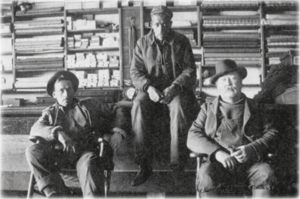
George Moody, the son of Mary Moody, worked as a laborer. He was married to Cora Robinson when their young child Walter died in 1899 at age one.
Around 1810 in nearby Henniker, another black man surnamed Haskell became known for marrying a white woman. “Because,” he claimed, “all the colored women feel themselves to be too good for me.” It’s not clear whether he was related to the Warner Haskells.
On the other side of Warner, in Sutton, another former slave married a white woman and eventually became prominent in his community. Lot Little was owned as a slave by a tanner named Thomas Little on the seacoast. Renaming slaves with unusual or humorous names based on their white families’ surname was common. A Revolutionary War veteran, Lot followed his ex-owner’s family to Sutton, where he managed properties for the family and, later, for himself.
Town records show that Lot Little paid taxes on property and voted. Unlike other black people, his family was always listed among the white residents. Dr. Lynn Clark, a Contoocook historian and independent researcher, speculates that he may have won an extra measure of respect due to his military service. Or, it may have been because he’d shown himself to be a responsible property owner, or simply because he was light skinned.
Despite that, an 1890 town history recalled Lot Little in this atypical description: “[He] clung affectingly to the family in which he had been kindly reared [i.e., his former owners], and the old feeling of dependence, the natural outgrowth of the peculiar relation of master and slave, made him ready to attach himself to [their] fortunes.”
Lot Little’s decedents stayed in Sutton. Eventually all traces of their mixed-race identity were lost, Lynn says. “Some of them are still here but they’re not perceived as black anymore.”
It was part of a pattern of either passing for white or moving away that began in the mid-1800s when a particularly virulent wave of racism swept across the country. Especially after the passing of the Fugitive Slave Act of 1854, requiring everyone to assist in the capture and return of escaped slaves, many black residents of New Hampshire left for Canada or the West.
For those who stayed—or whose stories remained, like Anthony Clark—many were simply ignored or “white-washed” to minimize their presence in the community. “Most people don’t know about these stories,” Lynn says. “The remark we hear most often is, ‘I had no idea.’”
With the help of organizations like the Historical Society and the Black Heritage Trail, we all have the opportunity to learn more about this aspect of our area’s history and celebrate the contributions African Americans made to our society.
Black Heritage Trail of New Hampshire, Coming Closer . . .
In 1995, Valerie Cunningham founded the Portsmouth Black Heritage Trail to commemorate the history of black people who lived in and around state’s only port city in early America. The trail developed a self-guided tour that uses public signage as well as educational programs and community events to celebrate this little-known story. Now the all-volunteer nonprofit organization that manages the Seacoast trail is spreading to other parts of the state with the goal of developing a statewide resource called the Black Heritage Trail of New Hampshire.
JerriAnne Boggis, the executive director of the organization, says that research is already underway and that local historians are working with educators to create a number of resources, including a self-guided tour that would be available online “so people can do it with their cell phones, they can find these sites,” she explains.
America’s First Black Celebrity
Most black people who lived in America in the 19th century were slaves, captured or bought like animals in Africa or the Caribbean. That was the background of Richard Potter. He was born in 1783 in Massachusetts, the son of a black mother owned as a slave by his father, a wealthy white colonial official.
Richard grew up in the Boston area, and he had an endearing charm and fast mind that quickly marked him as unique. When he was 16 years old, he traveled to Europe with a white family that employed him. It was there, among the artists and entertainers, that Richard began learning the creative skills that allowed him to become one of the first popular entertainers in America.
His skills included legerdemain (card and coin tricks) and acrobatics, but it was principally ventriloquism that led to his notoriety. That trick was practically unknown in the New World at the time.
Richard amazed and unnerved people with his ability to make it appear that voices were coming from handbags and animals, but his charismatic character helped make audiences comfortable. He had “A constant smile seeming to illuminate his face,” said one acquaintance. To his trickery, Richard eventually added songs, humorous speeches, and dancing on eggs.
When he later married Sally Harrys in 1808, Richard occasionally added her sweet voice to his music as the “Evening’s brush to sweep away care,” as he advertised his presentations.
As his reputation and repertoire grew, Richard took his act on the road, appearing all over New England. Around 1820, Richard toured all of pre-Civil War America, giving shows in southern slave states as well as in New York, Philadelphia, and parts of Canada. It was likely the first time any entertainer took such a wide-ranging circuit.
In 1813, Richard purchased land to establish a farm in Andover, about 25 miles northwest of Concord. He later told Nathan Hale, the famous patriot and newspaper editor:
“The surest anchor, I thought, was to have some determinate object always in view, and none appeared to me more decisively powerful, than an independence that would secure me from poverty and public charity, when advanced age or youthful competitors drove me from this temporary enjoyment. Having a good wife, well acquainted with country business, I concluded that instead of carrying her about with me as an assistant, it would be better to have a home, which would be to her a congenial occupation, and to me a polar star, towards which I would always set my course.”
Richard had a gentle, courteous manner but practiced a severe personal discipline. He told Hale that he “Avoided gambling, drinking, and idleness,” and became a “strong temperance man.” It is ironic, then, that Sally developed into an alcoholic whose irresponsible behavior hampered the family for years.
In John A. Hodgson’s recent biography Richard Potter: America’s First Black Celebrity, the author speculates about how much of the entertainer’s life was impacted by his skin color. In his early performing days, Richard was content and sometimes even encouraged people to speculate about whether he was a Hindu or from some other foreign culture. But most of his audiences apparently knew and accepted that he was, to use the term of the day, colored.
“His manners were impeccable, his behavior decorous and polite, his bearing gracious and almost courtly. But his complexion was dark, as was his wife’s,” one friend recalled.
The author did not uncover many specific incidents where the entertainer was hampered by racism, but it appeared to regularly add a tone of unpleasantness to his life. And it may have been part of the reason that an antagonism later developed between him and some of his Andover neighbors.
Richard died in 1835 and his wife passed away soon afterwards. They were buried on their farm, but their graves were later moved to a place near the local train station. The station—and the village—are now known as Potter Place. A New Hampshire historic marker commemorates the famous performer’s life.
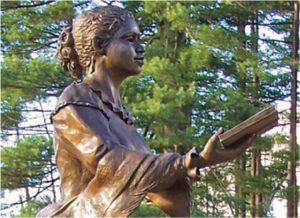
This memorial monument to novelist Harriet Wilson is in Milford, where she spent most of her early life. The statue was commissioned by the Harriet Wilson Project, a local organization that’s working to have Wilson’s historical book Our Nig: or, Sketches from the Life of a Free Black and other aspects of New Hampshire’s black history incorporated into the state’s history.
One of the main problems for historians researching the lives of early American black citizens in New Hampshire is the paucity of reliable source information. Since most black people—in fact, most Americans—had little or no formal education, there are few diaries, journals, or other personal papers available. A major exception is Our Nig: or, Sketches from the Life of a Free Black, an autobiographical novel written by Harriet “Hattie” E. Wilson.
Wilson was born in Milford in 1825 to a black father and a white mother and was still a young child when her impoverished mother abandoned her to a local family. Hattie lived with this family as an indentured servant until she was a teenager.
Our Nig is considered a fictionalized version of Wilson’s life under the oppressive yoke of the family. Originally published in 1859, it’s one of the first novels published by a black woman in North America.
Despite its sympathetic view of the lives of black people, the book was unpopular even among people like abolitionists in the North. Some historians say that was because it showed that freed black people in the northern states sometimes faced the same harsh treatment as many slaves in the southern states.

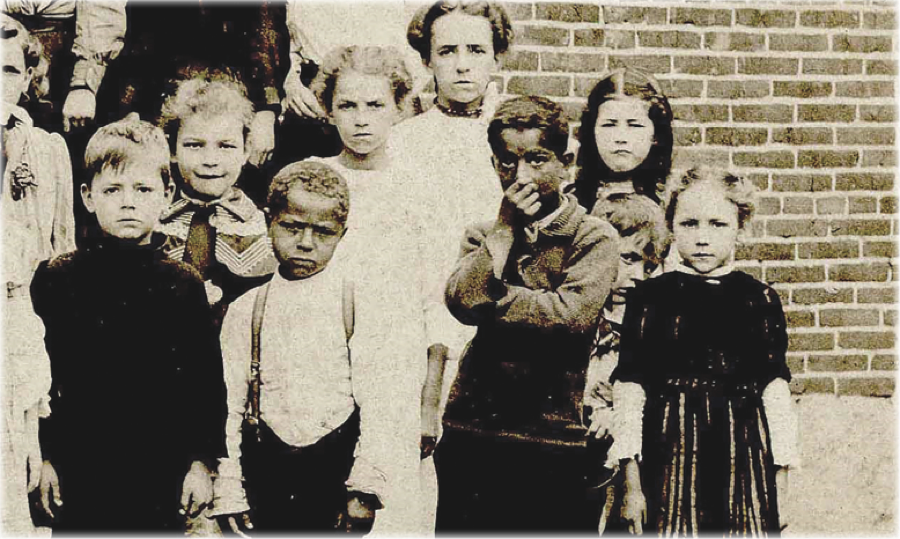
 View Print Edition
View Print Edition
Do you have any information on black familes in concord or loudan nh
“Across the story of America, the history of black people remains a darkened corner.“ What America do you live in? African heritage people and their many contributions to the economic, social & cultural formation of America is well documented.
I am a direct desendant of Caesar Lewis and am interested in any inforamtion you may have. Very interesting article. He is my 4th great grandfather. I am seeking ANY information you may have. He led a very interesting life, as a former slave, cattleman, author and as a Man in general. I truly enjoyed this read. Anthony Clark as well who is also connected. Please include more documentation so that the young ones know their accomplishments and they are not lost in history. They were in fact real as I am here. Simply, Thank you.
Well Written Article. Caesar Lewis 1755-14 MAY 1860 (A Centarian) is my direct descendant. Town History ” Cesar Lewis, died in 1862, aged 100″. He was a Waiter, Cattleman, and an Author of an ettique book. He married Gemima Blanchard and had descendants in Vermont. Anthony Clark was b. in Massachusetts.Harriet E Wilson’s book mentions characters such as the Blanchard family that can be documented as factual. I would be interested in obtaining any documentation regarding this article.
Thank you for this information. I plan on taking this model and setting up something similar for my state of Missouri. This was very informative and a delight to read all of the stories and moments in time told by you. I plan to visit and tour the area really soon. Quick question? What happened to the land Richard and his wife owned? The article said they were buried on their land and had their graves/bodies moved to an area near the train station. Did their family inherit land or did the family lose it after their death? Thank you
Fascinating. I have geneaology questions relevant to this topic. How best to find a Harriet C Wigfall, listed NYC, 1846 in Kimball Academy program.
Harriet marries in Ports mouth in 1859, and dies/is buried in Colebrook?
I cannot connect her life in SC to her travel to NY/NH.
Thx.
I am digging into family Genealogy, and find a woman of color boarding at Reuben Bugbee’s in Manchester NH per census, marrying James Legro in 1850, who goes on to serve NH in Civil War.
They live out their lives in Coos county.
Is there anyone to correspond with? Was hoping to physically dig in NH town histories this summer, but covid interferes.
Who did this research on Lot Little? There are numerous assertions that are not claimed elsewhere.
For instance: “[…] he managed properties for the family, and later for himself.”
Where does this information come from?
Also this: Lot’s “decedents [sic] stayed in Sutton. […]. Some of them are still here but they’re not perceived as black anymore.”
Which descendants stayed in Sutton? Lot Little was my 6x great-grandfather, and to the very best of my knowledge, Lot and all his children were gone from Sutton in 1817.